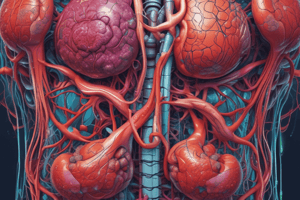Podcast
Questions and Answers
What is the main function of the nervous system?
What is the main function of the nervous system?
The body's speedy, electrochemical communication network.
Which of the following are types of neurons in the nervous system? (Select all that apply)
Which of the following are types of neurons in the nervous system? (Select all that apply)
- Interneurons (correct)
- Sensory neurons (correct)
- Hormonal neurons
- Motor neurons (correct)
The Central Nervous System (CNS) includes the brain and spinal cord.
The Central Nervous System (CNS) includes the brain and spinal cord.
True (A)
What does the Autonomic Nervous System (ANS) control?
What does the Autonomic Nervous System (ANS) control?
What is the role of the sympathetic nervous system?
What is the role of the sympathetic nervous system?
What does the parasympathetic nervous system do?
What does the parasympathetic nervous system do?
What are the four main lobes of the brain?
What are the four main lobes of the brain?
What is the role of the spinal cord?
What is the role of the spinal cord?
What are the main divisions of the nervous system?
What are the main divisions of the nervous system?
Which of the following are types of neurons?
Which of the following are types of neurons?
What is the function of the Somatic Nervous System (SNS)?
What is the function of the Somatic Nervous System (SNS)?
What does the Autonomic Nervous System (ANS) control?
What does the Autonomic Nervous System (ANS) control?
Which system prepares the body for stressful situations?
Which system prepares the body for stressful situations?
The Parasympathetic Nervous System conserves energy and calms the body.
The Parasympathetic Nervous System conserves energy and calms the body.
What are the two parts of the Central Nervous System (CNS)?
What are the two parts of the Central Nervous System (CNS)?
Which lobe of the brain is NOT one of the four main lobes?
Which lobe of the brain is NOT one of the four main lobes?
Flashcards are hidden until you start studying
Study Notes
The Nervous System
- Functions as the body's rapid, electrochemical communication network.
- Composed of all nerve cells within the peripheral (PNS) and central nervous systems (CNS).
- CNS includes the brain and spinal cord, while PNS connects CNS to muscles, glands, and sense organs.
Neuron Types
- Three main types of neurons facilitate information travel in the nervous system:
- Sensory neurons (afferent): Transmit information from senses to CNS.
- Motor neurons (efferent): Relay commands from CNS to muscles.
- Interneurons: Connect sensory and motor neurons within CNS.
Peripheral Nervous System (PNS)
- Divided into:
- Somatic Nervous System (SNS): Controls voluntary movements and skeletal muscles.
- Involves sensory and motor neurons for relaying information to and from CNS.
- Autonomic Nervous System (ANS): Regulates involuntary body functions (e.g., heartbeat, digestion).
- Operates automatically but can be consciously controlled.
- Somatic Nervous System (SNS): Controls voluntary movements and skeletal muscles.
Autonomic Nervous System (ANS) Divisions
- Sympathetic Nervous System: Prepares body for stress ("fight or flight") by:
- Increasing heart rate and force of contractions.
- Dilating airways for easier breathing.
- Mobilizing stored energy and enhancing muscular strength.
- Parasympathetic Nervous System: Conserves energy and regulates body functions during rest by:
- Slowing heart rate and decreasing blood pressure.
- Serves to calm and restore body processes.
Central Nervous System (CNS)
- Central control of body and mind functions, made up of brain and spinal cord.
- Brain divided into four lobes: temporal, parietal, occipital, frontal.
- Neurons form neural networks, with layers connecting for complex processing.
Spinal Cord
- Acts as a two-way information highway between CNS and PNS.
- Ascending neural fibers: Carry sensory information from body to brain.
The Nervous System
- Functions as the body's rapid, electrochemical communication network.
- Composed of all nerve cells within the peripheral (PNS) and central nervous systems (CNS).
- CNS includes the brain and spinal cord, while PNS connects CNS to muscles, glands, and sense organs.
Neuron Types
- Three main types of neurons facilitate information travel in the nervous system:
- Sensory neurons (afferent): Transmit information from senses to CNS.
- Motor neurons (efferent): Relay commands from CNS to muscles.
- Interneurons: Connect sensory and motor neurons within CNS.
Peripheral Nervous System (PNS)
- Divided into:
- Somatic Nervous System (SNS): Controls voluntary movements and skeletal muscles.
- Involves sensory and motor neurons for relaying information to and from CNS.
- Autonomic Nervous System (ANS): Regulates involuntary body functions (e.g., heartbeat, digestion).
- Operates automatically but can be consciously controlled.
- Somatic Nervous System (SNS): Controls voluntary movements and skeletal muscles.
Autonomic Nervous System (ANS) Divisions
- Sympathetic Nervous System: Prepares body for stress ("fight or flight") by:
- Increasing heart rate and force of contractions.
- Dilating airways for easier breathing.
- Mobilizing stored energy and enhancing muscular strength.
- Parasympathetic Nervous System: Conserves energy and regulates body functions during rest by:
- Slowing heart rate and decreasing blood pressure.
- Serves to calm and restore body processes.
Central Nervous System (CNS)
- Central control of body and mind functions, made up of brain and spinal cord.
- Brain divided into four lobes: temporal, parietal, occipital, frontal.
- Neurons form neural networks, with layers connecting for complex processing.
Spinal Cord
- Acts as a two-way information highway between CNS and PNS.
- Ascending neural fibers: Carry sensory information from body to brain.
Studying That Suits You
Use AI to generate personalized quizzes and flashcards to suit your learning preferences.



